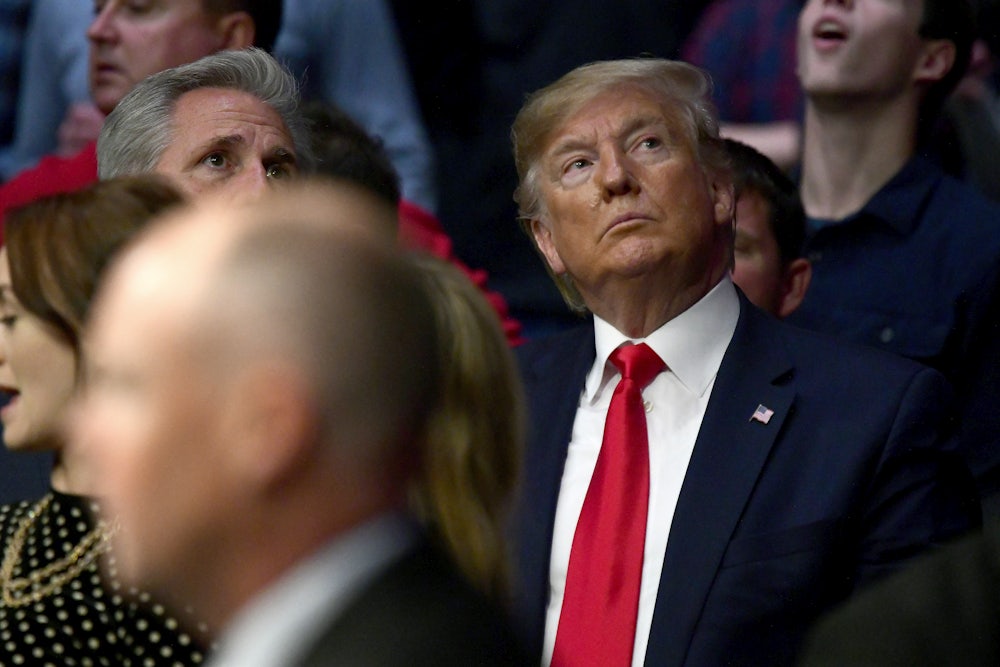When Donald Trump entered Madison Square Garden on Saturday evening, he may very well have been looking for a safe space. Six days earlier, he attended Game Five of the 2019 World Series. Perhaps expecting a warm response—ISIS leader Abu Bakr al-Baghdadi had died a day earlier—he was, instead, booed mercilessly for a very long time. The crowd, twisting his unofficial 2016 campaign motto, even chanted, “Lock him up!”
Madison Square Garden is, of course, in Manhattan—the liberal bastion that Trump has largely avoided over the course of his political career. But it was also hosting UFC 244, a pay-per-view mixed martial arts Ultimate Fighting Championship event. Trump has a long relationship with ultimate fighting. In 2001, he helped save the sport, which was nearing financial ruin, by hosting fights at his Atlantic City Taj Mahal casino. He has deep ties to its president, Dana White, who praised Trump as a “fighter” at the 2016 Republican National Convention. And while UFC fans are not quite as conservative as many expect, there could be no doubt that this was a friendlier audience.
It didn’t make much of a difference. Although some precautions were taken—Trump’s arrival wasn’t announced, as it was during the World Series—he was, once again, enveloped in boos. “The booing began immediately,” wrote Why We Fight author Josh Rosenblatt. “The music on the loudspeakers was turned up, either to herald Trump’s arrival or to stifle the crowd’s displeasure in reaction to it, but the sound of those boos was overwhelming.”
The response to these two incidents has largely fallen under two categories. On the one hand, Trump and his defenders have claimed that the media was manipulating video and audio to exaggerate the boos and mislead the public. On the other, there has been a lengthy back-and-forth about the civility of booing the president and chanting that he should be imprisoned.
But there is another side to these incidents. Both provide visceral, undeniable examples of the president’s enormous and unprecedented unpopularity—and serve as useful contrasts to dominant media narratives about the president and his supporters.
Trump, as my colleague Matt Ford noted after Game Five of the World Series, “rarely ventures out in public before crowds that aren’t predisposed to like him.” He tends to participate in events where he knows he will receive a rapturous response, like Monday’s pre-election rally with Kentucky Governor Matt Bevin in Lexington, Kentucky.
While polls have shown that Trump has been broadly and consistently unpopular from the moment that he entered in the White House, he has successfully used these events to change the conversation. He frequently tweets and speaks about commanding the loyalty and admiration of a silent majority of real Americans. He and his supporters use frequently doctored, always misleading Electoral College maps to suggest that he is beloved by the vast swathes of the country—and that his detractors are contained in coastal enclaves that exist in an alternate reality.
This effort has been aided by the media, which has consistently paid significantly more attention to Trump’s supporters than his detractors—despite the fact that the latter have been a much larger group for the past several years. The New York Times has rightfully received criticism for parachuting its reporters into diners in Trump states to ask voters why they’re sticking with the president in spite of whatever embarrassing or borderline treasonous thing he had done most recently. The result has artificially inflated the size of the president’s base of support and its importance in the national perception.
The result is a skewed portrait of the American electorate, one in which Trump’s supporters’ preferences and beliefs are constantly fretted over and in which his detractors remain comparatively anonymous—a true silent majority. The coverage gets further skewed as news outlets fall over themselves to prove that they are, in fact, paying attention to his base.
The boos that rained down at the World Series and at UFC 244 are palpable proof of reality, which is that Trump is the most despised president in recent memory. The polling has shown this consistently, but only in the abstract. Trump’s counter-narrative—the packed arenas—are used to show that the pollsters and pundits are wrong about him. But the last week has eviscerated the myth of Trump’s popularity. News outlets and their viewers have been forced to acknowledge that Trump’s opponents are as real as his supporters—that they are, in fact, more numerous.
That is why the president and his adult children were so insistent that he wasn’t actually being booed at Madison Square Garden. They have improbably held on to the idea that Donald Trump is a secretly popular president and have hoodwinked the media into endlessly covering his rallies and his supporters. This week, at long last, we saw the way that Trump is greeted when he leaves the bubble that he, with the help of the media, has built around himself.
